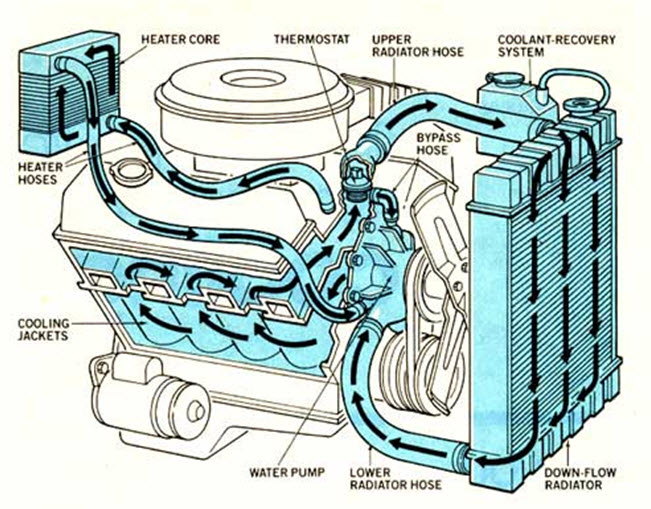Site pages
Current course
Participants
General
Module 1. Classification of Farm Power Sources
Module 2. Classification of IC Engines & Therm...
Module 3. Performance Characteristics
Module 4. Engine Components
Module 5. Engine Operating System
Module 6.:Engine Fuel System
Module 7. Engine Governor
Module 8. Engine Cooling & Lubrication system
Module 9. Engine Ignition System
26 April - 2 May
LESSON 25. METHODS OF COOLING SYSTEM & COMPONENTS
25.1 Air cooling system

An air blower or fan is used in the tractors having air cooled engines to circulate the air for dissipating the heat from the engine surface, cylinder in particular. Special baffles/fins are used to direct the air to reach the desired heated component and to avoid any hot spot. Size and spacing of the fins depend upon theamount to be removed, temperature of air, speed of air, material of fins and spacing between the fins and cylinder size. Generally, large number of short fins are considered to be better that small number of large fins. For an effective cooling the surface area of the metal in contact with the air is to be increased. Higher pressure of air is required when the spacing between the fins is reduced. Copper and steel alloys have also been used to improve the rate of heat transfer due to their better heat conductivity. Air cooled engines are comparatively lighter , easier to warm up than the water cooled engines. Air cooled engines can be used in extreme weather conditions where water may get freezed.
25.2 Water cooling system
In water cooling system, water jackets are provided around the engine cylinder or liners. The circulating water in these jackets absorb the heat from the cylinder surface and then heated water is cooled by the air passing in the radiator. The water cooling system consists of water jackets, water pump, radiator, thermostat valve, fan, belt and pulley etc. Although, water is the most commonly used cooling agent whereas, special coolants having better and desired properties like corrosion free, higher boiling point etc. are also available in the market and recommended also for obtaining and marinating higher engine efficiency.

The water is made to circulate in the water jackets continuously with desired pressure and speed with the help of water pump driven by belt. Generally, water pumps are of centrifugal type and consist of water inlet and outlet with impeller which makes the water to come out from the pump outlet by a centrifugal force. The pump inlet is connected with radiator at bottom to draw the coolant/water from the radiator. When the engine is cooled, the thermostat valve remains open and same water/coolant is being circulated through the water jackets. By the time, water/coolant gets heated, the thermostat valve is opened to make water pass through the radiator to dissipate heat by coming intact with the air passing through the radiator. The radiator is located in the front of tractor/vehicle and it consists of water/coolant tank, tubes and pressure cap on the tube. This pressure cap is used to prevent water evaporation and increase the pressure with in the cooling system. The temperature difference between the air outside and water inside the radiator is high, and the heat is dissipated more quickly from water to the air. The air is generated with help of fan and also by the forward movement of the tractor.
Generally, engine operates efficiently in the temperature range of 800C to 900C and it always desired that the engine temperature should reach to this temperature as early as possible in cool weather conditions and remain in this temperature range only under excessive hot weather conditions. The thermostat is designed to maintain this temperature range by regulating the temperature of water/coolant circulating in the water jackets.
Proper maintenance schedules are to be followed to make these engine cooling system run properly to ensure desired engine efficiency and fuel economy. Running the engine at low temperature results into loss of fuel as unburnt fuel, dilution of lubricating oil and running the engine at high temperature causes wearing of engine parts and complete seizure.